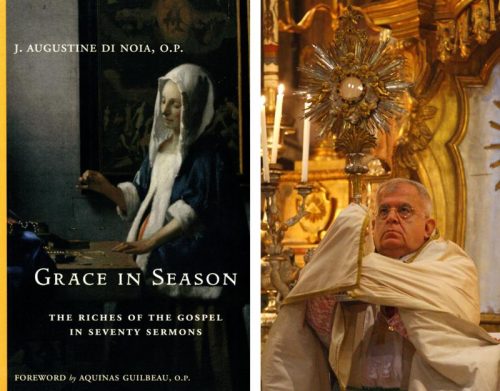WASHINGTON (CNS) — Here is a Christmas homily titled “Christ Was Born For This” by Archbishop J. Augustine DiNoia, adjunct secretary of the Vatican Congregation for the Doctrine of the Faith. A Dominican, he taught theology for many years at the Dominican House of Studies in Washington. His homily below quotes from “Good Christian Men Rejoice,” the English title of the carol “In Dulci Jubilo,” attributed to the 14-century German Dominican mystic Blessed Henry Suso:
Today we sing: “Good Christian men rejoice / With heart and soul and voice. / Give ye heed to what we say, / Jesus Christ is born today. / Ox and ass before him bow, / for he is in the manger now. / Christ is born today. Christ is born today.”
The spell of this birth — in the form of poinsettias, wreaths, garlands, lights, music, family celebrations, gift-giving — penetrates the remote corners of our aggressively secular age. There is this wondrous grace: Christ is born today. God has become one of us, upsetting all human expectations of what is possible and impossible, of what can be and what cannot be. The Son of God has come in the flesh — a pure, stunning, and, as we say, amazing grace. Who could have foreseen it, planned for it, or arranged it? What purely human conditions could have made way for it? None. Christ is born today — notwithstanding human unreadiness and skepticism — Christ is born today.
God, who desires to share the love and communion of his life with us, makes himself accessible in the incarnate humanity of his only-begotten Son — “that we might share in the divinity of Christ who humbled himself to share in our humanity” (Collect). When regarding this event we take the God’s-eye-view that our faith makes possible, we see how fitting it is that God should make his Son “like us in all things but sin,” drawing us into the communion of his divine life along humanly accessible pathways suffused with his grace: words, gestures, objects, sacraments — tangible, visible, audible, persons and things, full of human and divine significance. “No one has ever seen God. The only Son, God, who is at the Father’s side, has revealed him”(John 1:18).
But there is more. We also sing: “Good Christian men, rejoice, / with hearts and souls and voice. / Now ye hear of endless bliss, / Jesus Christ was born for this. / He hath opened heaven’s door, and man is blessed evermore. / Christ was born for this,” we sing, “Christ was born for this.”
Born for what? In his depiction of the Nativity, the 16th-century Italian artist Lorenzo Lotto painted a crucifix into a niche in the background behind the kneeling figure of St. Joseph. Christ was born for this, Lotto seems to tell us — for the Cross. In Liz Lemon Swindle’s beautiful Madonna and Child — titled “Be It Unto Me” — Mary looks out with a certain apprehension into a future beyond the viewer’s sight, while the Child’s raised eyebrows wrinkle his forehead. One artist’s crucifix in the niche parallels the other’s Cross on the horizon. For over the peaceful scene of the Nativity falls the shadow of the Cross. The Christian tradition has almost universally seen in the harsh circumstances of Christ’s birth “at midnight, in Bethlehem, in piercing cold” a prefiguring of the brutal circumstances of his death on the Cross. “Ox and ass before him bow; and he is in the manger now.” But in the future the wood of the Cross will take the place of the wood of the manger. Be it done unto to me, indeed. He willingly embraces the Cross for our sakes, by his perfect obedience erasing the deadly effects of our disobedience. “He hath opened heaven’s door, and man is blest forevermore.” “Christ was born for this,” we sing, “Christ was born for this.”
But there is yet more to sing about: “Good Christian men, rejoice, / with hearts and souls and voice. / Now ye need not fear the grave. Jesus Christ was born to save. / Calls you one and calls you all, to gain his everlasting hall. / Christ was born to save,” we sing, “Christ was born to save.”
Thus we have, in the first place, the grace of the “Nativity of our Lord Jesus Christ according to the flesh”(Roman Martyrology), and then, through his Cross, “the purification from sins”(Hebrews 1:3). Now we have the glory. “And the Word became flesh and made his dwelling among us, and we saw his glory, the glory of the Father’s only Son, full of grace and truth”(John 1:14). And “he took his place at the right hand of the Majesty on high”(Hebrews 1:4). We have grace of the Incarnation, the victory of the Cross, and the Resurrection and life everlasting. This is the full meaning of Christmas, the arc from Bethlehem to Golgotha, and beyond. “Now ye hear of endless bliss. Jesus Christ was born for this.”
We give up the forceful proclamation of this mystery, my brothers and sisters in Christ, and we are left with a pitiful dry husk of moral maxims and human wisdom. At the heart of the Christmas story is not merely a wonderful moral ideal but the person of Jesus Christ and the salvation and new life he makes possible for us. “Now ye need not fear the grave. Jesus Christ was born to save.”
Editor’s Note: This homily is excerpted from “Grace in Season: The Riches of the Gospel in Seventy Sermons” by J. Augustine Di Noia, OP. Cluny Media (Providence, R.I., 2019). Available for purchase on www.clunymedia.com and www.amazon.com.






















